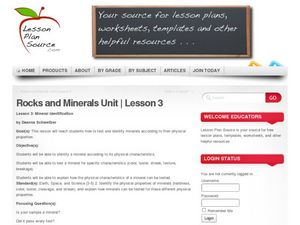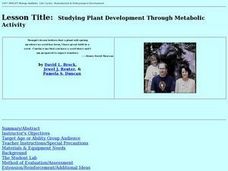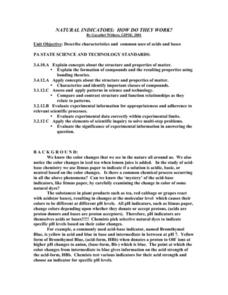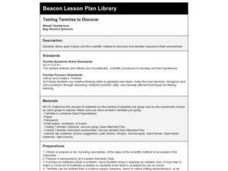Curated OER
Presentations
Students give presentations. In this unit culmination lesson, students present their bridge projects to parents. Students test their bridges and are evaluated using a rubric.
Curated OER
Rocks and Minerals Unit
Young scholars test and identify minerals according to their physical properties. In this mineral analysis lesson, students brainstorm ways to identify rocks and list their ideas on chart paper. Young scholars study samples in pairs and...
Curated OER
Conductors and Insulators
Fifth graders investigate conductors and insulators by testing their hypotheses. They use copper wire and batteries to light a bulb. They use a penny and a plastic spoon to determine which is an insulator and which is a conductor.
Curated OER
Where Did the Science Experiments Go?
Hands-on science experiments are essential for student learning.
Curated OER
Lesson 18, My Friend Linda
Students explore Huntington's Disease. In this biology lesson, students read My Friend Linda and examine the ethical issues brought to light in the story. Students discuss biotechnology issues and genetic testing.
Curated OER
Qualitative Analysis and Ksp Calculations
In this compounds worksheet, students determine which anion is present in solution from the results of testing with various reagents. Students compare the solubility of different compounds in water. This worksheet has 7 fill in the blank...
Curated OER
Water Quality Assessment
Students evaluate water quality of different sources. In this water assessment lesson students chemical testing, identify biological factors in the stream, and write a paper on their position of the stream's quality.
Curated OER
Sink or Float?
Students examine how weight and balance can effect if an item sinks or floats. They listen to the book "Who Sank the Boat?" by Pamela Allen, and discuss how the smallest animal sank the boat. Students then conduct an experiment in...
Curated OER
Magnets 2: How Strong is Your Magnet?
Students work together to test the strengths of various types of magnets. After testing, they create a graph showing how the strength changes as the distance from the magnet increases. They discuss how forces can act from various...
Curated OER
Ethics and Reproductive Issues: The Dilemma of Choice
Students examine the ethical issues raised by three situations in which prenatal testing may be used to prevent or facilitate pregnancy.
Curated OER
Paper Clip Walk
Fifth graders investigate the behavior of magnetism using magnets. They discuss magnetic force, and conduct an experiment, testing how many paper plates can be stacked together before the force of the magnetic field no longer affects a...
Curated OER
Design Your Own Biological Experiment
Young scholars work together to research a topic of interest to them. They form hypothesis and complete experiments testing them. They present their findings to the class.
Curated OER
Understanding the pH Cycle within the Aquarium
Students discuss places they have been where the air seemed hard to breathe. They discuss if they could "see" the humidity or smell. Students discuss ways this might relate to the fish in the aquarium. The teacher introduces pH and how...
Curated OER
Studying Plant Development Through Metabolic Activity
A hands-on activity which allows learners to learn about cellular respiration. This lesson contains a range of investigations testing the rates of cellular respiration to demonstrate the relationship between metabolic rates of...
Curated OER
Don't Get Caught!
In this fish worksheet, students read about fish and write about how they can help fish. They write about how they can save fish, fish migration, fish getting sick, and testing for pollution in water.
Curated OER
Pond Ecology
Fifth graders examine pond ecology, testing how temperature affects the respiration rate of fish. They collect various living things found at a pond, and identify the animal and plant life discovered. They observe a pond community in an...
Curated OER
Natural Indicators: How Do They Work?
Students describe characteristics and common uses of acids and bases. They describe the role of natural indicators in the chemistry of acids and bases after testing and making observations on a variety of plant extracts. Students observe...
Curated OER
Genetics, Birth Disorders, and Pregnancy
Students in an alternative school setting for pregnant teens examine various facets of pregnancy including prenatal and postpartum testing, genetic influences, and additional risk factors. Through videos, hands-on activities, and small...
Curated OER
Blowing Bubbles, Blowing Colors
Students examine the properties of bubbles by testing different bubble making materials. For this scientific experiment lesson, students create a bubble brew with different soaps while observing the different strengths and sizes of...
Curated OER
Testing Soils for Garden Planting
Sixth graders collect soil samples and record the location of the samples by using GPS.
Curated OER
Testing Termites to Discover
Students design an experiment to discover how termites respond to their environment.
Curated OER
Ozone Testing Tools
Students develop an experiment to measure the amounts of ground level ozone present in their area. They collect data, access a related website and compare measurements. They present their findings.
Curated OER
How Can Gel-electrophoresis Help in the Identification of a Dna Sample?
Students investigate the principles of gel electrophoresis and DNA testing. They watch and discuss a PowerPoint presentation, and solve a DNA mystery using the information they learned from the presentation.
Curated OER
Lab for Truss Design and Testing
Students design and build their own truss. In this physics lesson, students calculate the forces and maximum load. They complete a full scale diagram of their design.
Other popular searches
- Science Test Preparations
- Science Test Preparation 2
- Primary Science Fair Testing
- Fair Testing Science

























